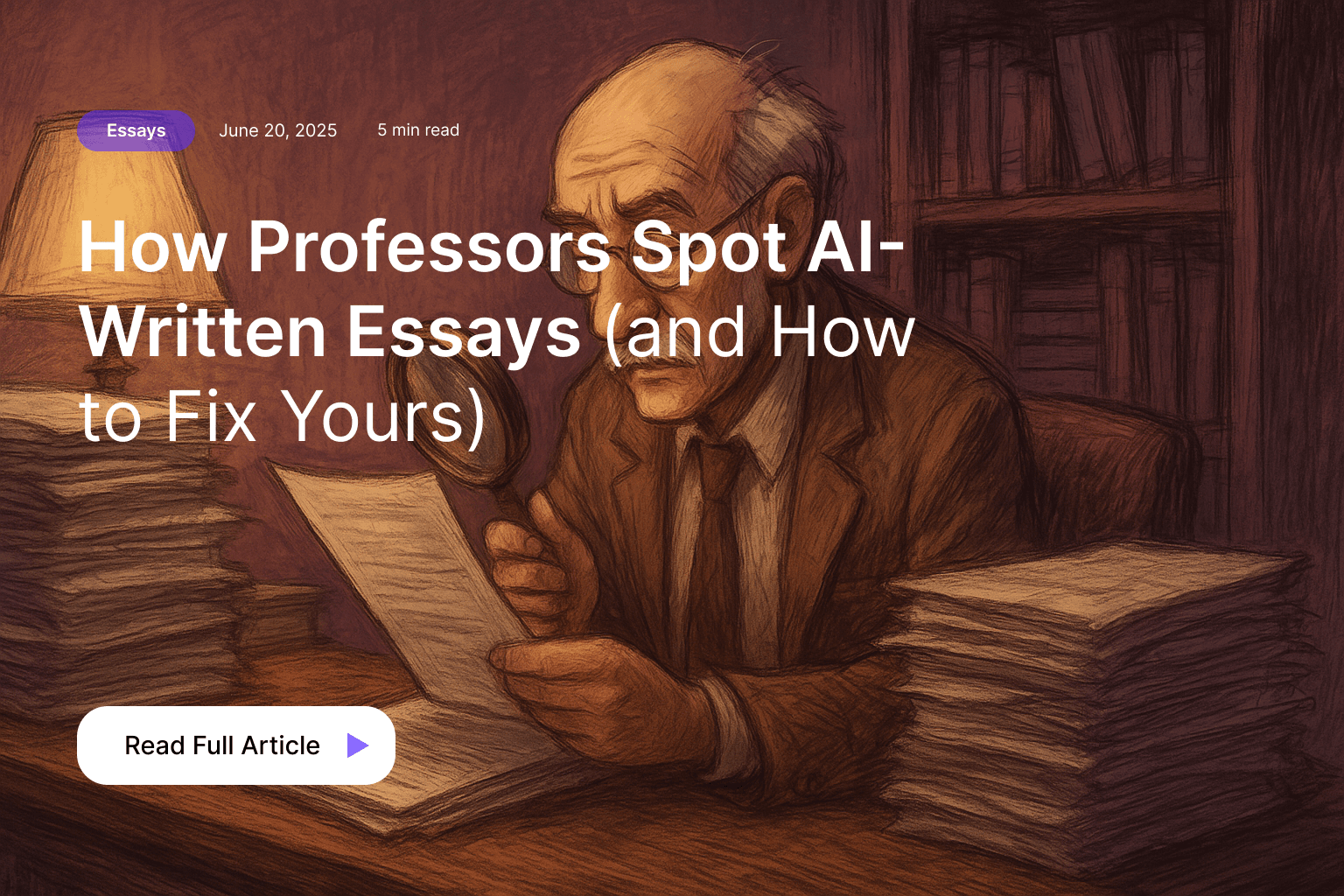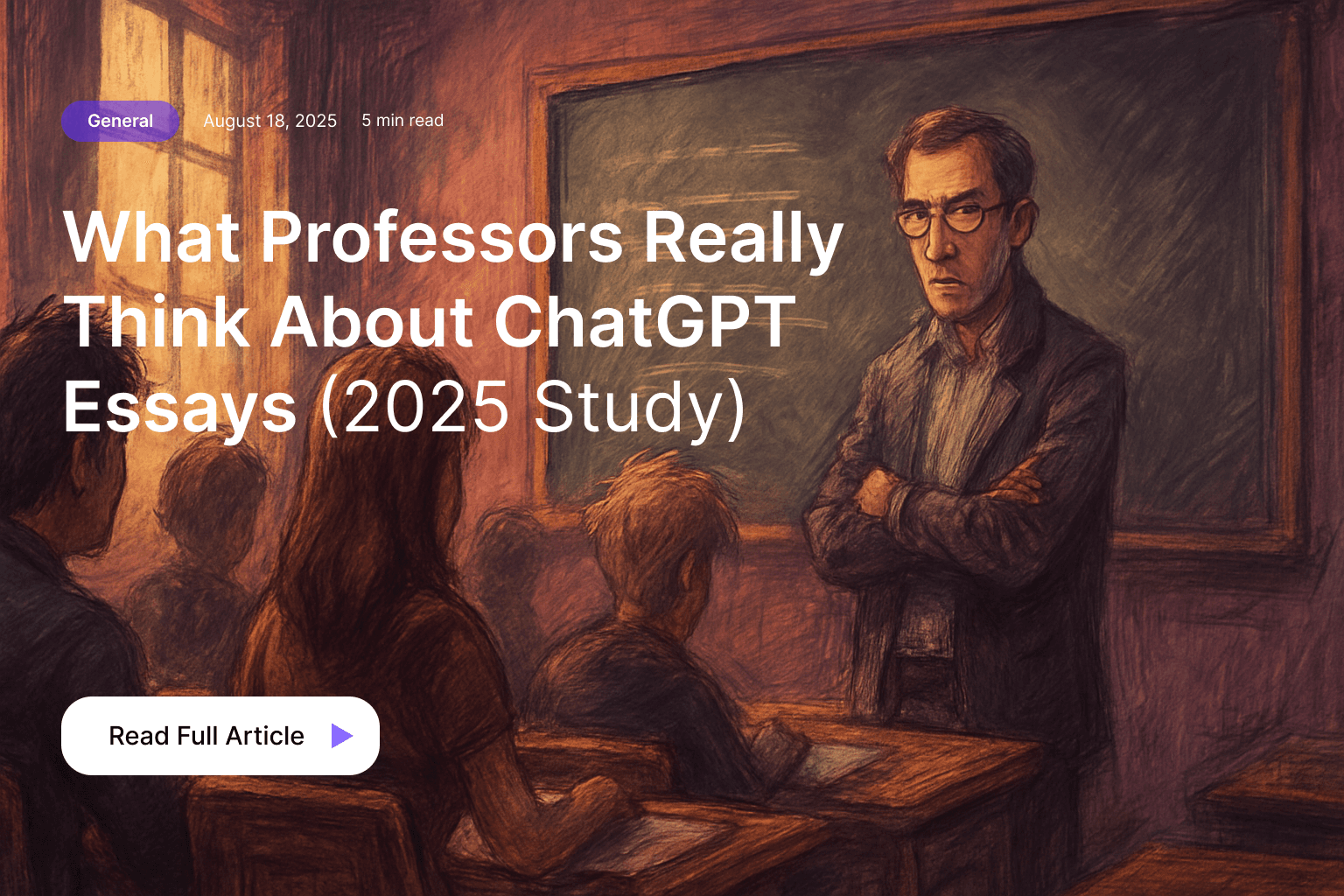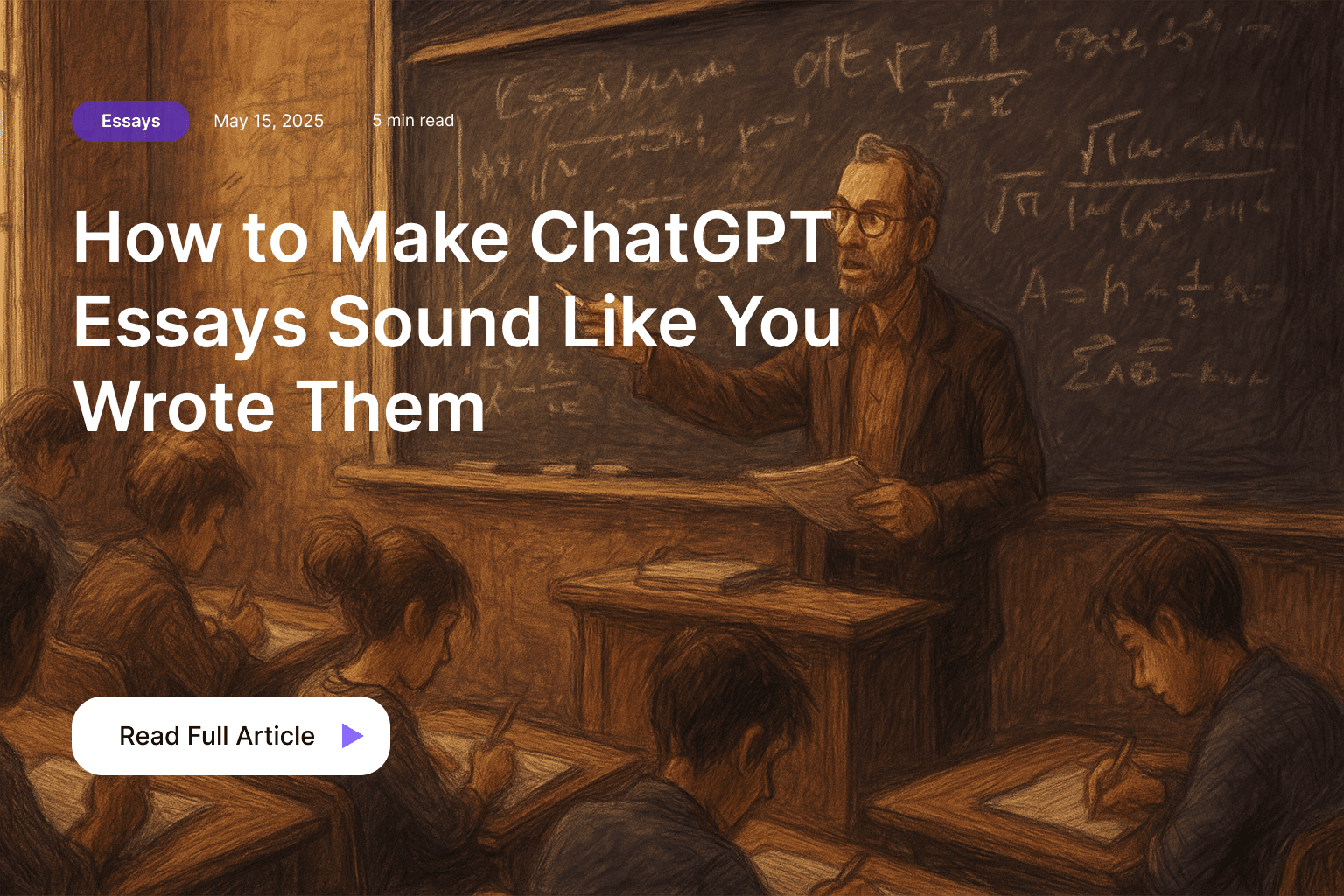Let’s be honest, everyone’s tried it.
You open ChatGPT, type your essay prompt, and in seconds you have a neatly formatted response that looks way better than what you could have written at 2 a.m. with caffeine and panic as your only friends.
But then something happens. You read it again.
It sounds… off. Too polished. Too symmetrical.
And a voice in your head whispers: What if my professor can tell?
You’re not paranoid. Professors can tell, and not just because of AI detectors.
In this post, we’ll explain how professors recognize AI-written essays, what actually gives them away, and how you can rewrite your essay to sound human while keeping all the clarity and structure that made you use AI in the first place.
1. Professors don’t need an AI detector to notice
AI detectors exist, but most experienced professors rely on something stronger — intuition built from reading hundreds of essays every semester.
Here’s what tips them off:
a) The “too even” tone
AI essays tend to have perfectly balanced sentences, with no variation in rhythm, no signs of a real writer’s voice. Human essays, even good ones, have moments of awkward phrasing, sudden emphasis, or a sentence that runs a little long because the writer was excited.
b) The structure that feels… mechanical
ChatGPT essays often follow a robotic five-paragraph pattern:
Intro → three clean body paragraphs → conclusion.
They sound correct but lifeless, like someone teaching a structure rather than using it to argue something.
c) Empty transitions
AI loves connectors like “Furthermore,” “In conclusion,” “Moreover,” but rarely uses them to build tension or flow. A professor reading that pattern instantly senses template writing.
d) Generic evidence
AI text often refers vaguely to “many studies,” “experts suggest,” or “recent research,” without specific data or citations. Professors see this as filler.
e) Overconfidence
Ironically, AI essays sound more confident than human ones. Phrases like “It is clear that” or “This proves that” appear too often, without the humility academics expect from students.
2. What AI detectors actually check
If your university uses tools like Turnitin’s AI detection, here’s what happens behind the scenes.
These tools analyze linguistic patterns, not plagiarism. They look for:
- Predictable phrasing (AI tends to use mid-probability words)
- Low variance in sentence length
- Unnatural coherence (ideas that flow too smoothly)
- Lack of context references (no personal or temporal cues)
In other words: if your essay reads like something that could’ve been written by anyone, detectors flag it.
That’s why rewriting tools like Essaytone don’t “trick” detectors, they rewrite AI-generated text into natural human academic language, restoring the rhythm, variety, and tone that machines lack.
3. Why rewriting beats paraphrasing
Most students panic-edit their AI essays by swapping words with synonyms.
That doesn’t work.
Detectors and professors can still tell, because the underlying sentence structure and thought pattern remain robotic. Rewriting, on the other hand, means rethinking how the sentence communicates the same idea.
Take this example:
AI version: “Education has always played a crucial role in shaping human societies and developing cultural values.”
Paraphrased: “Education has constantly been important in forming societies and influencing culture.”
Rewritten: “Throughout history, societies have relied on education to define their values and guide progress.”
The last version sounds natural. It keeps the meaning but re-centers the sentence around a human rhythm, something AI rarely does on its own.
4. What makes AI writing sound unnatural
If you’ve ever wondered why your ChatGPT essay sounds robotic even when the grammar is flawless, here’s why:
| Symptom | What it reveals |
|---|---|
| Perfectly balanced sentences | Machine-generated pacing |
| No contractions (“do not,” “cannot”) | Lack of informal rhythm |
| Excessive transition words | Over-templated structure |
| Vague evidence | No lived knowledge or examples |
| Predictable word choices | Mid-probability pattern writing |
Good writing, especially in academia lives in the imperfections, in the variations
That’s the secret to sounding human.
5. How to humanize your essay before submitting
You don’t need to throw away your AI-generated draft. You just need to rewrite it with clarity and authenticity.
Here’s a simple process used by grad students who rely on tools like Essaytone’s AI-to-Human Rewriter:
Step 1: Keep the structure, not the sentences
Your AI essay probably organizes ideas well. Copy that skeleton, but rewrite every sentence in your own flow. Use your own examples or course material wherever possible.
Step 2: Add personal reasoning
Insert why you think something matters.
AI explains what’s true; humans explain why it’s interesting.
Instead of “Climate change affects agriculture,” try
“Farmers in coastal regions are already adjusting planting seasons because rainfall patterns have shifted.”
Step 3: Rewrite tone with Essaytone
Paste your draft into Essaytone’s AI Academic Rewriter. It detects robotic patterns, stiff tone, and over-templated phrasing, then rewrites each line into natural academic rhythm while preserving your structure.
Step 4: Read aloud once
You’ll instantly hear if something sounds robotic. Human writing breathes. If you run out of breath halfway through a sentence, it’s too long.
Step 5: Keep your voice consistent
Professors notice voice shifts between your intro and conclusion.
Use Essaytone section-by-section, not all at once, so your tone evolves consistently.
6. Ethical line: rewriting ≠ cheating
Using AI responsibly in academia means keeping your ideas your own.
It’s fine to use ChatGPT to brainstorm, outline, or refine grammar — but the reasoning, argument, and evidence must be yours.
Rewriting AI text through a humanizing tool doesn’t replace your work; it clarifies it.
Think of it as the academic equivalent of language polishing.
Even the most respected journals use professional editors to make dense writing readable. You’re doing the same, just using modern tools.
7. Why clarity equals credibility
Professors don’t just want originality; they want readability.
An essay that’s clear, direct, and logically structured makes you look like someone who understands the material deeply.
That’s why clarity-rewriting tools exist, not to mask AI, but to elevate your communication.
When your essay reads fluently:
- You score higher on coherence and argumentation.
- You pass AI detectors naturally.
- You sound confident, not copied.
8. Example: Turning an AI draft into a human one
Let’s take a real example that might come from ChatGPT.
Prompt: “Discuss the role of social media in modern political movements.”
AI Draft: “Social media has become an essential platform for political expression and mobilization. Many activists use platforms like Twitter and Facebook to spread awareness and encourage civic participation. It is clear that social media has transformed the way people engage in politics.”
Now, rewritten for clarity and human tone:
Rewritten with Essaytone:
“Over the past decade, social media has changed how citizens engage with politics. Platforms like Twitter and Facebook allow activists to organize in real time, rally support, and bypass traditional news outlets. This immediacy has made political movements more visible and sometimes, more unpredictable.”
Notice what changed:
- More natural sentence variety
- Specific examples
- A touch of human interpretation (“more visible and sometimes, more unpredictable”)
That’s what human writing feels like.
The takeaway here
Professors aren’t out to punish students for using AI.
They just want to see signs of thinking, the human process behind the words.
If your essay feels too mechanical, don’t panic. You don’t need to start over.
You just need to rewrite with intention and let a clarity tool like Essaytone help shape it into something natural, readable, and genuinely yours.
Because the goal isn’t to hide from AI detection. The goal is to write like you actually understand what you’re saying.




